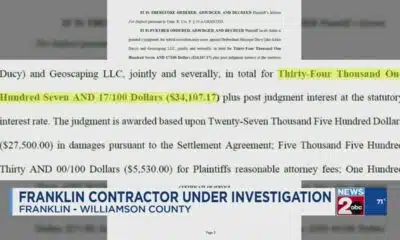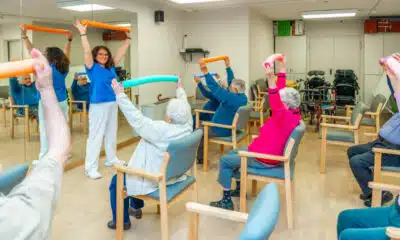News from the South - Louisiana News Feed
HHS agrees to review mifepristone safety based on anti-abortion white papers
by Sofia Resnick, Louisiana Illuminator
May 16, 2025
The Trump administration has agreed to review the safety and efficacy of abortion pills, based on white papers funded by far-right organizations, which reproductive health experts say are unscientific and contradict decades of research showing low rates of serious adverse events for the most common form of abortion.
But during a U.S. Senate hearing Wednesday, Health and Human Services Secretary Robert F. Kennedy Jr. called the findings “alarming.” He said he would order the Food and Drug Administration to “do a complete review” of the mifepristone-misoprostol regimen — but first he suggested the drug label “should be changed,” based on the data the anti-abortion movement has used to lobby Trump officials for the past two weeks.
Kennedy was answering a question from U.S. Sen. Josh Hawley (R-Missouri), whose attorney wife argued against the safety of mifepristone before the U.S. Supreme Court in 2024. The senator has been part of a strategy, which began after FDA approval in 2000, to restrict or ban medication abortion at the federal level. Earlier Wednesday, more than 100 groups sent the HHS secretary and the FDA commissioner a petition to restrict the use of the two-drug regimen.
Some anti-abortion activists see this as a significant win.
“The opportunity that this information provides to all of us, I believe, is the single biggest pro-life breakthrough since the overturn of Roe versus Wade, and we all know what a huge landmark that was,” said longtime movement leader David Bereit on a webcast Wednesday night. “And now we have an opportunity to continue to advance the cause of life.”
Bereit is the executive director of the Life Leadership Conference, a multimillion-dollar venture founded this year to help fund anti-abortion projects, according to the National Catholic Register.
Data-driven strategy to convince Trump’s FDA to review abortion drug
Self-published in late April by the Ethics & Public Policy Center and the Foundation for the Restoration of America, the white papers found that about 11% patients who took mifepristone experienced serious adverse events, which is 22 times higher than what’s on the current drug label for mifepristone.
The FDA’s prescribing label for mifepristone under the brand name Mifeprex says that based on U.S. and non-U.S. clinic studies, serious adverse reactions were reported in less than 0.5% of women.
The Ethics & Public Policy Center (EPPC) and the Foundation for the Restoration of America papers say their high sample size (865,727 “prescribed mifepristone abortions”) and recent time frame (2017 to 2023) make theirs the most comprehensive studies on the matter and trump the hundreds of peer-reviewed studies that have to-date found low rates of serious adverse effects.
Reproductive health researchers and fact-checkers have criticized the EPPC’s broad classification of serious adverse events and pointed out that the analysis still shows low rates of the more serious risks typically linked to medication abortion, such as sepsis (0.1%), transfusion (0.15%), and hospitalization related to the abortion (0.66%).
Wednesday’s joint letter to HHS and the FDA, signed by Americans United for Life and more than 100 anti-abortion groups, describe their evidence as sufficient proof for the FDA to, even before evaluating new data, “reinstate the previous protections for women prescribed mifepristone.”
Subscribe to Reproductive Rights Today
Want a better understanding of abortion policy in the states? Sign up for our free national newsletter. Reproductive Rights Today is a comprehensive daily wrap-up of changes to reproductive rights in the states, the front lines in the fight over abortion access in a Post-Roe America.
The FDA lifted “previous protections” between 2016 and 2021, following emerging safety data, that allowed people to get medication abortions up to 10 weeks’ gestation instead of seven, no longer required multiple in-clinic visits, and allowed the medicines to be prescribed via telemedicine and sent through the mail. These changes have made medication abortion the most accessible form of termination and have allowed abortion rates to rise in a country where more than half the states have banned abortion partially or outright.
That’s why medication abortions have become a target of the anti-abortion movement.
Previous papers finding that mifepristone was unsafe were produced by the Charlotte Lozier Institute in 2021 and 2022 and cited by a federal judge in a lawsuit brought by anti-abortion doctors that was rejected by the U.S. Supreme Court last year. It has since been revived with new plaintiffs. Those papers were peer-reviewed and published by the major academic publisher Sage. But under scrutiny, they were eventually retracted for methodological flaws and undisclosed conflicts of interest related to the peer review. The Charlotte Lozier researchers took legal action against Sage, arguing the retractions were political and that a pro-abortion bias exists in science and academia. A spokesperson for Susan B. Anthony Pro-Life America, which is the parent organization of Charlotte Lozier, said neither organization was involved in producing or funding the most recent analysis.
This time, the groups sharing these claims with federal and state lawmakers have not publicly disclosed the source of the data nor the people who conducted the research.
“In the research that went into this, there were a number of doctors and scientists and data scientists who helped with this analysis, but for fear of reprisal, for fear of retaliation, they need to keep their names quiet,” said John T. Anderson, the Ethics & Public Policy Center’s president, who co-authored his organization’s white paper with director of data analysis Jamie Bryan Hall, on Wednesday’s webcast.
John Mize, the CEO of Americans United for Life, said he proposed using health insurance claims data to uncover health harms from medication abortion during an interview with the organization last year.
Mize said he quickly learned that groups in the anti-abortion movement were already beginning to comb claims data. The Ethics & Public Policy Center paper has spread as part of a multifaceted legal and messaging strategy, which Politico recently reported has been internally dubbed “Rolling Thunder” and includes trying to bring False Claims Act cases against doctors who tell patients the drugs are safe, based on the paper.
Mize acknowledged this paper was not peer-reviewed or published in a journal, which is standard in credible scientific research, but he said it wasn’t meant to stand as evidence alone. He said the goal was to get the FDA to review medication-abortion safety, and reconsider new regulations.
“I’m not saying that this is, like, definitive proof,” Mize told States Newsroom. “But it points in the direction that the FDA should say, ‘You know what? Maybe we need to do more to research this.’”
The Ethics & Public Policy Center advocates for policies restricting abortion and helps train physicians to testify against abortion in legislatures and in the courts. The organization was on the advisory board of the Heritage Foundation’s Project 2025, the controversial presidential blueprint that President Donald Trump distanced himself from during the campaign but has since begun to implement, including on abortion.
On EPPC’s board of directors sit two powerhouses of the Christian right movement: Princeton University professor Robert P. George and Leonard Leo, the co-chairman of the influential legal network the Federalist Society. Leo is credited with hand-picking Trump’s first three Supreme Court nominees, whom Trump promised were open to overturning Roe v. Wade, and with it almost 50 years of federal abortion rights.
EPPC’s communications director Hunter Estes said their research project began last fall and was done separately from the paper published by the Foundation for the Restoration of America, a nonprofit run by far-right political operative Doug Truax. Truax is also the founder and CEO of a health insurance group based in Illinois. He declined to comment. The Foundation paper lists no author and credits the research to “our clinical team of board-certified obstetrician-gynecologists.”
Breaking down the claims
Reproductive health experts told States Newsroom that the sweeping claims in the white papers largely rely on stretching the standard definition of serious adverse events, lumping in deadly infections like sepsis with emergency visits that could be merely observational; preexisting chronic conditions; and instances where an additional treatment was needed to complete the abortion.
“The coding of all emergency department visits as serious adverse events to me suggests they don’t understand abortion,” said Ushma Upadhyay, an epidemiologist at the University of California San Francisco, who has been researching mifepristone safety for most of her career. “There’s demonstrated research that people are more likely to go to the emergency room if they live further away from the abortion provider and … they want reassurance about their symptoms. That is not a serious adverse event.”
Estes defended including emergency room visits in the list of serious adverse events, even though the FDA does not explicitly. He said his team only counted emergency room visits that were related to the abortion and were more serious than “mild cramping.”
“Thus, if a woman took the chemical abortion pill and then got into a car accident or broke a bone, that did not count,” Estes told States Newsroom in an email. “This led us to exclude 72% of emergency room visits that took place within 45 days of abortion from our analysis.”
Another major red flag for reproductive health researchers is that the anti-abortion groups have not named their data source or specific codes used.
Both groups say they analyzed commercially available all-payer health insurance claims for the years 2017 through 2023. The EPPC paper says the database it used “includes information on hospital and office visits, diagnoses, procedures, and prescriptions processed through private health insurance, Medicaid, Medicare, TRICARE, and the Department of Veterans Affairs (VA). The data excludes transactions for which the insurer is also the provider (as is the case with some HMOs and much VA care), as well as cash pay transactions (which are disproportionately common for abortion). This dataset provides longitudinal tracking of medical diagnoses, procedures, and prescriptions for each patient.”
Estes said the paper’s description of their dataset should be enough to replicate it.
“We are not legally permitted to share that information or provide the data set,” Estes said. “However, these datasets are both widely used. … Large companies throughout the health care and health insurance industries almost certainly have access to the data we used, as do many researchers who publish in academic journals.”
But Julia Strasser, a reproductive health researcher and professor at George Washington University’s Fitzhugh Mullan Institute for Health Workforce Equity who regularly works with claims data, said she couldn’t identify the EPPC’s data source. She said there’s a high learning curve for understanding and analyzing this data. And she said claims databases vary widely.
“It might be the highest number of patients, but there are a lot of problems with this study,” Strasser said. “In public health in general, it’s rare that there is one single study or one single publication that is sort of the silver bullet that proves or disproves something. It’s about the totality of the evidence. And we have 100 studies about mifepristone in the real-world context in the last 25 years that are showing that it’s safe and effective.”
But it’s enough to compel the Trump administration to take action on medication abortion, something abortion-rights advocates say could create major barriers to getting care even in states with major abortion bans or restrictions. The EPPC paper does not report any findings related to telemedicine abortion, but asserts the FDA should return to previous protocols that did not include telemedicine while reviewing the data further. It also suggests the agency should “reconsider its approval altogether.” The administration has not yet announced any restrictions on medication abortion.
“It is terrifying to think that our access to safe FDA-approved medications turns on President Trump’s gut instinct rather than credible scientific evidence,” said Americans Civil Liberties Union attorney Julia Kaye on a webinar with other abortion-access advocates Thursday. “There is still time for President Trump to make good on his campaign promise not to strip away access to medication abortion, but all signs right now suggest that this FDA review based on junk science is just about fulfilling the wish list of anti-abortion extremists.”
Louisiana Illuminator is part of States Newsroom, a nonprofit news network supported by grants and a coalition of donors as a 501c(3) public charity. Louisiana Illuminator maintains editorial independence. Contact Editor Greg LaRose for questions: info@lailluminator.com.
The post HHS agrees to review mifepristone safety based on anti-abortion white papers appeared first on lailluminator.com
Note: The following A.I. based commentary is not part of the original article, reproduced above, but is offered in the hopes that it will promote greater media literacy and critical thinking, by making any potential bias more visible to the reader –Staff Editor.
Political Bias Rating: Left-Leaning
This content reflects a left-leaning perspective as it strongly critiques the Trump administration’s efforts to review and potentially restrict the abortion pill mifepristone based on research funded and promoted by far-right and anti-abortion organizations. The article emphasizes reproductive health experts’ and abortion rights advocates’ views that the studies used to justify restrictions are unscientific or flawed, and it highlights concerns about maintaining access to safe medication abortion. While it reports on the anti-abortion movement’s strategies and claims, the overall framing and language favor reproductive rights and skepticism toward the regulatory review initiated by conservative actors.
News from the South - Louisiana News Feed
Monday Noon Tropics Update: Fernand heads north, Invest 99 fizzles
SUMMARY: Tropical Storm Fernand is improving in organization with 60 MPH winds but faces increasing wind shear and cooler waters as it moves north, likely weakening by Wednesday without threatening land. Invest 99 in the eastern Caribbean remains disorganized with strong wind shear, leading the National Hurricane Center to drop its development chance to 0%. The hurricane season has reached Fernand, with Gabrielle and Humberto next on the list, though no new formations are expected soon. Approaching the peak hurricane season around September 10, activity is likely to continue through September, with cooling temperatures and increased rain chance as fall approaches.
Meteorologist Alexandra Cranford tracks Tropical Storm Fernand and Invest 99 at noon on Monday, August 25, 2025.
News from the South - Louisiana News Feed
Fox 14 Your Morning News: Movement Monday
SUMMARY: Fox 14 Your Morning News’ Movement Monday features partner exercises focused on fun and fitness. The segment includes reverse lunges, one-legged squats, and partner high-five squats to build strength and balance. They use a ball or pillow for back-to-back seated twists and tossing exercises to engage the core. The workout ramps up with side-to-side knee kicks and ab work to boost abdominal strength. Lastly, partners perform planks combined with cardio moves like jumping through feet, emphasizing proper form, breathing, and rhythm to maximize calorie burn and stability. The lively, encouraging approach makes fitness enjoyable and accessible.
Amy returns for another lively installment of ‘Movement Monday,’ which includes a variety of exercises such as reverse lunges, one-legged squats, and planks, all aimed at promoting fitness and teamwork.
News from the South - Louisiana News Feed
Extreme heat in prisons brings more legal challenges, pressure on states
by Amanda Hernández, Louisiana Illuminator
August 25, 2025
Summer heat is bearing down on U.S. prisons, where temperatures in uncooled cells can climb well into the triple digits.
Facing growing pressure from advocacy groups, lawsuits and climate projections that show hotter days ahead, some state prison systems are moving to install air conditioning and expand cooling measures — though many facilities remain years away from significant upgrades.
But in other states, such efforts have stalled or failed. That may lead to more lawsuits in the future, experts say, even as judges may raise the bar for such cases.
An emphasis on being “tough on crime” and prioritizing other public safety measures may have contributed to less attention on prison conditions in some states. In others, slowing revenue growth and pressure to rein in corrections spending could be making new investments a harder sell.
At least two states this year, Virginia and Texas, considered legislation addressing excessive heat in prisons but neither measure became law. The Texas bill would have required the state Department of Criminal Justice to purchase and install climate control systems in all of its facilities by the end of 2032. About two-thirds of the state’s correctional facilities have only partial or no air conditioning.
The measure passed the House but did not advance in the Senate before the legislature adjourned in June.
GET THE MORNING HEADLINES.
In Virginia, lawmakers approved a bill that would have required the state corrections department to install heat and air conditioning in its prisons and to ensure cell temperatures not exceed 80 degrees. Republican Gov. Glenn Youngkin vetoed it, citing the cost of installation and operational burdens. Youngkin also wrote that existing state corrections data “does not substantiate the claims of extreme temperatures or health risks.”
But in Delaware, the fiscal year 2026 capital budget approved last month includes $2 million in funding to install air conditioning at the James T. Vaughn Correctional Center.
These changes mark the latest actions in a long-running debate over how correctional systems respond to rising summer temperatures — an issue that affects both incarcerated people and staff. Some of the policy debates and facility updates this year follow years of advocacy and litigation over the health, safety and operational challenges posed by heat in correctional settings.
The problem of excessive heat in prisons has persisted for decades and has unfolded alongside other challenges, including chronic understaffing and overcrowding. In some cases, these problems have led to extended facility lockdowns, even during the summer months.
“There are people working in prisons and they have the right to work in climates that are comfortable,” said Nancy La Vigne, a criminal justice researcher and dean of the School of Criminal Justice at Rutgers University. “When they’re not, there’s retention issues, and it’s hard to replace staff. And when you don’t replace staff, then you have challenges in maintaining the safety and security of the facility.”
In New York, for example, correctional officers staged a three-week strike earlier this year and many didn’t return to work. Some facilities now are operating with 30%-60% fewer guards than needed, resulting in some incarcerated people getting only an hour or two outside of their cells each day.
A 2023 study published in the peer-reviewed PLOS One journal found that mortality in state and private prisons rose during periods of extreme heat, with deaths increasing 3.5% on extreme heat days and up to 7.4% during three-day heat waves. Between 2001 and 2019, nearly 13,000 people died in prison during the summer months, almost half of them in the South, though the study did not determine how many of those deaths were directly attributable to heat.
Climate change is fueling longer, more intense periods of extreme heat. Exposure to extreme heat can worsen conditions such as cardiovascular disease, diabetes and asthma, and has also been linked to worsening mental health and higher suicide rates among incarcerated people.
“Average temperatures are rising, and you’re going to have more and more states around the country where incarcerated people are held in conditions that are not livable because they’re too hot,” said Sharon Dolovich, a law professor and director of the Prison Law and Policy Program at the University of California, Los Angeles.
Some upgrades
At least 44 states lack universal air conditioning within their prison facilities, even in regions known for sweltering summer temperatures, according to a 2022 USA Today analysis. A recent Reuters investigation also found that nearly half of state prisons across 29 states have partial or no air conditioning in housing units.
But some states are investing millions to update their prison facilities.
In North Carolina, corrections officials are working toward their goal of installing air conditioning in all 54 state prisons by 2026. To date, 33 facilities are fully air-conditioned, 17 are partially air-conditioned, and four have no air conditioning, according to its dashboard.
In California, the Department of Corrections and Rehabilitation, which operates 31 adult prisons, has spent $246 million in the past five years on cooling improvements at five prisons, according to a department spokesperson.
Lawmakers this year also approved funding for the Air Cooling Pilot Program at three facilities, with $17.6 million allocated for fiscal years 2025-26 and $20 million for fiscal years 2026-27. It will evaluate the effectiveness of two alternatives prior to a statewide plan to address high indoor temperatures across the California prison system.
The Texas Department of Criminal Justice, as of Aug. 1, is building 12,827 “cool beds,” or prison cells in air-conditioned units, and is in the process of procuring an additional 7,162, according to its dashboard.
Texas is one of the states most closely associated with heat-related deaths in prison. A 2022 study estimated that, on average, 14 deaths per year in Texas prisons are associated with heat. And a Texas Tribune analysis found that at least 41 incarcerated people died during a record-breaking heat wave in 2023.
In March, a federal judge ruled the extreme heat in Texas prisons is “plainly unconstitutional,” but declined to order immediate air conditioning, saying the work could not be completed within the court order’s 90-day window and temporary systems might delay a permanent fix.
‘More miserable’
Sweltering summer heat can turn prisons into pressure cookers. People inside already may have health conditions, limited access to cooling, or take medications that make it harder for their bodies to handle the heat. And research suggests that high temperatures can heighten irritability and aggression, sometimes fueling more conflicts between incarcerated people or with staff.
“It makes you more miserable. … If you to the point of even thinking about suicide, that’s just going to add to it,” said Ronald McKeithen, who spent 37 years incarcerated in Alabama prisons and is now the director of second chances at the Alabama Appleseed Center for Law and Justice. McKeithen recalls feeling “on edge” due to tension among other incarcerated people on hot days.
At the Oshkosh Correctional Institution in Wisconsin, Devin Skrzypchak said the heat worsens his bladder condition, and he often can’t get the incontinence briefs he needs. The heat forces him to drink more water, and on days when ice isn’t available, he’s left drenched in sweat.
“At times, it’s a living hell. … It can be very excruciating,” Skrzypchak wrote in a message to Stateline through the facility’s messaging platform.
D’Angelo Lee Komanekin — who has spent about 25 years in and out of different Wisconsin corrections facilities — said prison architecture plays a major role in why temperatures inside climb so high.
“The planet is getting hotter and hotter,” said Komanekin, who relies on a small plastic fan to stay cool. Komanekin also is incarcerated at the Oshkosh Correctional Institution. “They’re doing nothing about the architecture. Some institutions’ windows open, some don’t, but most of the doors have steel doors with trap doors.”
Older prison designs that rely heavily on steel and concrete building materials often trap heat, making it difficult to keep temperatures down in the summer. Aging facilities also are less likely to be equipped for the installation of central air conditioning.
Some state prison systems, including Alabama’s and Wisconsin’s, are adding air-conditioning or air-tempering systems to new prison construction and major renovation projects.
Future legal battles
Legal experts say the issue of excessive heat in prisons is likely to become more pressing as climate change drives longer and hotter summers.
Extreme heat in correctional facilities has already been the subject of litigation in dozens of states, with plaintiffs arguing that high temperatures constitute cruel and unusual punishment under the Eighth Amendment. Court rulings in these cases have varied, but some experts say even more lawsuits are likely if facilities do not adapt.
“The conditions are going to worsen. [Incarcerated people are] going to be looking for every possible avenue for assistance they can,” Dolovich, the UCLA law professor, told Stateline.
One of the latest cases comes from Missouri, where the nonprofit law firm MacArthur Justice Center filed a class-action lawsuit in May on behalf of six incarcerated people at Algoa Correctional Center.
The lawsuit alleges that the conditions violate their constitutional rights under the Eighth Amendment. It seeks to require the Missouri Department of Corrections to work with experts to develop a heat mitigation plan that keeps housing unit temperatures between 65 and 85 degrees. If the department cannot meet that standard, the plaintiffs are asking for the release of three of the incarcerated people who have less than a year remaining on their sentences.
Lawsuits such as the Missouri case often focus on claims that extreme heat worsens existing medical problems. To proceed, they must meet two legal requirements: proving the heat poses a serious health or safety risk, and showing prison officials knew about the danger but failed to address it, according to Dolovich, whose work has focused on the Eighth Amendment and prison conditions.
Courts may also raise the bar for proving such claims if judges echo decisions in cases with similar Eight Amendment arguments related to the death penalty and homelessness, Dolovich said. Judges have shifted, she said, toward a “superadding terror, pain and disgrace” standard under the Eighth Amendment — a higher threshold requiring proof that conditions were created with the intent to cause unnecessary suffering.
Dolovich added that some recent court decisions have provided only narrow remedies, such as ordering ice and fans instead of installing air conditioning.
“Prison officials have a moral and a constitutional responsibility to respond to changing conditions. In this case, it means air conditioning. … Anything less than that, to me, is indefensible.” she said.
Stateline reporter Amanda Hernández can be reached at ahernandez@stateline.org.
YOU MAKE OUR WORK POSSIBLE.
This report was originally published by Stateline, part of the States Newsroom nonprofit news network. It’s supported by grants and a coalition of donors as a 501c(3) public charity. Stateline maintains editorial independence. Contact Editor Scott S. Greenberger for questions: info@stateline.org.
Louisiana Illuminator is part of States Newsroom, a nonprofit news network supported by grants and a coalition of donors as a 501c(3) public charity. Louisiana Illuminator maintains editorial independence. Contact Editor Greg LaRose for questions: info@lailluminator.com.
The post Extreme heat in prisons brings more legal challenges, pressure on states appeared first on lailluminator.com
Note: The following A.I. based commentary is not part of the original article, reproduced above, but is offered in the hopes that it will promote greater media literacy and critical thinking, by making any potential bias more visible to the reader –Staff Editor.
Political Bias Rating: Center-Left
This article focuses on the human and constitutional costs of inadequate climate control in U.S. prisons, highlighting health risks, lawsuits, and advocacy efforts for improved conditions. It presents facts and critiques the failure of some states, particularly those with conservative leadership, to act on air conditioning installation, framing these failures in terms of moral responsibility and human rights. While it remains largely factual and balanced, the emphasis on systemic issues within prisons, climate change impact, and critiques of financial and political obstacles—especially mentioning vetoes by Republican governors—indicates a center-left leaning perspective, which tends to prioritize social justice, human rights, and governmental intervention to address public welfare challenges.
-
News from the South - Alabama News Feed7 days ago
U.S. agriculture secretary announces end to subsidies for solar panels on farmland
-
News from the South - Kentucky News Feed6 days ago
First of its kind clinical trial offers new hope for Kentuckians at risk of dementia
-
News from the South - Georgia News Feed7 days ago
Don't eat this shrimp sold at Walmart due to possible radiation contamination: FDA
-
News from the South - Arkansas News Feed7 days ago
Cities across the US are embracing AI guidelines for local government workers
-
Our Mississippi Home6 days ago
MSU Unveils Mixed-Use Development Featuring Boutique Hotel, Cultural Landmark
-
News from the South - Arkansas News Feed6 days ago
‘Alligator Alcatraz’ probed by Dems as ICE detention centers multiply in states
-
News from the South - Alabama News Feed6 days ago
Grants to boost local emergency alert systems in question as public media agency closes
-
News from the South - Texas News Feed7 days ago
The Innocent and the Executed: James Beathard’s Long-Forgotten Story












































